Interaction between low-rank coal and biomass during degradative solvent extraction
JIANYi-ming,LIXian,,*,ZHUXian-qing,ASHIDARyuichi,WORASUWANNARAKNakorn,HUZhen-zhong,LUOGuang-qian,YAOHong,ZHONGMei,*,LIUJing-mei,MAFeng-yun,MIURAKouichi
(1.Key Laboratory of Coal Clean Conversion and Chemical Process Autonomous Region, College of Chemistry and Chemical Engineering, Xinjiang University, Urumqi 830046, China;2.State Key Laboratory of Coal Combustion, College of Energy and Power Engineering,Huazhong University of Science and Technology, Wuhan 430074, China;3.Department of Chemical Engineering, Kyoto University, Kyoto 615-8510, Japan;4.The Joint Graduate School of Energy and Environment, Center of Excellence on Energy Technology and Environment, King Mongkut’s University of Technology Thonburi, Bangkok 10140, Thailand)
Abstract: A degradative solvent extraction at around 350 ℃ for low-rank coal or biomass wastes upgrading and fractionation was proposed in our previous work. The extraction yield of low-rank coal is relatively lower than that of biomass. In this work the blends of low-rank coal and biomass were treated by this method at 350 ℃ to investigate the interaction between them. The results showed that the yields and elemental compositions of the extracts obtained from the blends were slight different to the calculated results, which were calculated by assuming that there was no interaction between the coal and biomass. The slight promotion of yield was judged to be caused by the catalytic action of the minerals in the coal for thermal decomposition of biomass. It was worth to note that the elemental composition, molecular weight distribution, chemical structure, thermal decomposition behavior and thermoplastic behavior of the extracts obtained from low-rank coal, biomass and their blend, were rather similar to each other, independent of the properties of the raw feedstocks. Overall, the interaction between low-rank coal and biomass during the extraction was not significant. On the other hand, the proposed degradative solvent extraction method was fit not only by single low-rank coal and biomass but also by their blends to produce the product having similar physicochemical properties. This implied that an industrial system of degradative solvent extraction can use coal, biomass or their blends as feedstock at the same time without modification or adjustment.
Key words: low-rank coal; biomass; blends; degradative solvent extraction; upgrading
Efficient utilization of low grade carbonaceous resources, such as low-rank coal and biomass waste, has been paid more and more attention recently. Low-rank coals are inevitably requested to be utilized efficiently because of the rapid depletion of high grade coal, such as bituminous coal, in the world[1-3]. Biomasses, considered as a carbon neutral resource, have received more attention at present not only due to the abundant availability but also the flexibility as a chemical feedstock. Various technologies have been developed for the utilization of these kinds of low grade carbonaceous resources[4-6]. However, rather high contents of oxygen-containing compounds, moisture or ash of them cause various problems for storage, transportation and efficient conversion by existing technologies. Thus, the pretreatment of dewatering and upgrading are essential for efficient utilization of these resources. Furthermore, if these low grade carbonaceous resources are used as the feedstocks of chemicals and carbon materials, it might have to develop methods to effectively convert them to intermediates independent of the raw materials. However, the treatment conditions and product properties of the existing technologies for this low grade carbonaceous resource conversion are usually different because of the different properties of the raw materials[7].
The authors have recently proposed a degradative solvent extraction method which treats low-rank coals or biomass wastes in a nonpolar solvent at around 350 ℃ to dewater and remove oxygen functional groups, and separate them into several fractions[8-13]. The fractions included unextractable fraction (residue) which was the so-called upgraded coal if low-rank coal was the feedstock, the high-molecular-weight extract fraction (deposit) which precipitated as solid from the solvent at room temperature, the low-molecular-weight extract fraction (soluble) which was soluble in the solvent at room temperature and finally recovered as solid by removing the solvent, the liquid fraction (liquid) mainly consisted of water, and gas product with major composition of CO2. The solubles and deposits were almost free from water and ash, have the carbon content of as high as 85% and oxygen content as low as 7%, much lower than their raw biomass. Thus, the degradative solvent extraction process was a “carbon enrichment” process. The promising utilizations of the upgraded coal, soluble and deposit as fuels, chemicals or carbon materials precursors were proved in our previous works[14-21].
However, the soluble and deposit yields of low-rank coal extraction only ranged from 19%-31% and 4%-17%, respectively[3,10]. They were obviously lower than those of the biomass extraction, which ranged from 26%-51% and 5%-29%, respectively[9,11,22]. The relatively lower extraction yield of low-rank coal should be caused by that there were only some noncovalent bonds, such as hydrogen bonds, which were broken during the thermal treatment at the temperature lower than 350 ℃[23]. On the contrary, a series of complex chemical reactions, such as dehydration, decarboxylation and
decomposition reactions, occurred during the thermal treatment of biomass at the temperature over 200 ℃[24,25]. Some researchers used polar solvent, such as alcohols, phenolics and water, for thermal extraction of low-rank coals to enhance the extraction yield[26,27]because such compounds were act as not only solvent but also reactant during the extraction[23]. It was already found that such kinds of compounds can be formed during thermal treatment of biomass[11,28,29]. Therefore, if the blended low-rank coal and biomass were treated by the degradative solvent extraction, such kinds of compounds formed through biomass pyrolysis may improve the extraction yield of low-rank coal extraction. In order to confirm it, in this work the blends of low-rank coal and biomass were thermal extracted at 350 ℃ by this method, to investigate the interaction between low-rank coal and biomass during extraction.
1 Experimental
1.1 Samples and solvents used
Rice straw (from Thailand, abbreviated to RS), Leucaena (woody biomass from Thailand, LC), Mae moh coal (lignite from Thailand, MM), Loy yang coal (lignite from Australia, LY) and the blends of coal and biomass (LC/MM, RS/MM, LC/LY and RS/LY) were employed as raw materials. The ratio of coal to biomass in blends was 1 to 1 on dry basis. The properties of the raw materials were shown in Table 1. 1-methylnaphthalene (1-MN) was used as a non-polar solvent for the degradative solvent extraction.

Table 1 Ultimate and proximate analyses of raw materials
*: calculated by difference
1.2 Experimental procedure
Since the treatment at around 350 ℃ was found to be effective for low-rank coals and biomasses in our previous works[9,10,16], the degradative solvent extraction in this work were performed at 350 ℃. Figure 1 shows the schematic diagram of the apparatus (autoclave) used for the extraction. The procedure was described in detail in our previous paper[9,10]. The reactor was charged with as-received sample (13 g on dry basis) and 1-MN (300 mL). The sealed autoclave, after purged by N2, was heated up to 350 ℃ at a heating rate of 5 K/min and then kept for 60 min under autogenous pressure. The extracts and residue were separated by opening the valve below the filter at the extraction temperature. The extract and solvent were collected in the reservoir which was cooled by circulating cooling water. Part of the extract, precipitated at room temperature from the solvent, was separated from the solvent by filtration and termed deposit. Another part of the extract, soluble in the solvent at room temperature, was obtained as solid by a rotary evaporator and termed soluble. Small amount of light fraction (liquid) was remained in the solvent. The residue, deposit and soluble were then dried under vacuum for 6 h at 150 ℃ to remove the residual solvent. The yields of residue, deposit and soluble were determined by weight. The gaseous products were quantified by GC. The yield of liquid was determined by difference.
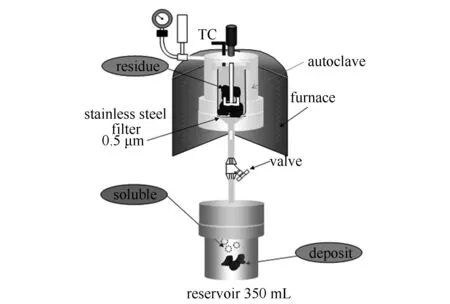
Figure 1 Schematic diagram of the experimental apparatus
1.3 Product analyses
The thermal decomposition behavior analyses were performed using a thermogravimetric analyzer (Shimadzu, TGA50). The elemental analysis was performed by a CHN analyzer (Yanaco, CHN MT-6 M). The molecular weight distribution (MWD) was measured by a laser desorption/ionization time-of-flight mass spectrometry (Shimadzu/Kratos, KOMPACT-MALDI-II). Chemical structure was estimated by the FT-IR (JEOL, JIR-WINSPEC 50). The softening/melting behavior was examined by a thermomechanical analyzer (Shimadzu, TMA). The TMA estimates the relative displacement of the sample when the sample in a platinum pan of 6 mm I.D. was heated under 10 g of load.
2 Results and discussion
2.1 Extraction yields
Figure 2 shows the yields of single raw material extractions on weight basis. The yields of gaseous products, consisting of mainly CO2, were from 2.8% to 10.9%. The yields of biomass extracts including soluble and deposit, ranged from 33.6% to 35.1%, are significantly higher than those of low-rank coal extracts. On the contrary, the yields of low-rank coal residues were significantly higher than those of biomass residues. It was found in our previous work that the extracts were much more valuable products than residues because of their characteristics of high carbon content, low ash and moisture content, and so on[16,17,19,30]. Thus, on the viewpoint of practical utilization it is beneficial to improve the extraction yield of low-rank coal. The liquid yields of biomass extractions are around as high as 38.0%, which consists of around 5.0% of organics and 33.0% of water[9]. It is found that much oxygen containing compounds, such as alcohols and phenolics, are formed during biomass pyrolysis or hydrothermal treatment[29,31]. However, the liquid obtained from low-rank coal extraction has relatively low yield with almost solely of water[32].
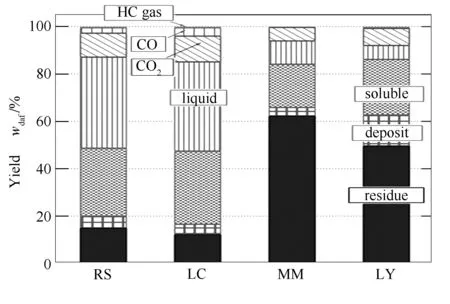
Figure 2 Extraction yields of single raw materials
Figure 3 shows the yields of blend extractions. The yields, calculated by assuming that there was no interaction between the coal and biomass during the extraction, are also added for comparison purpose.
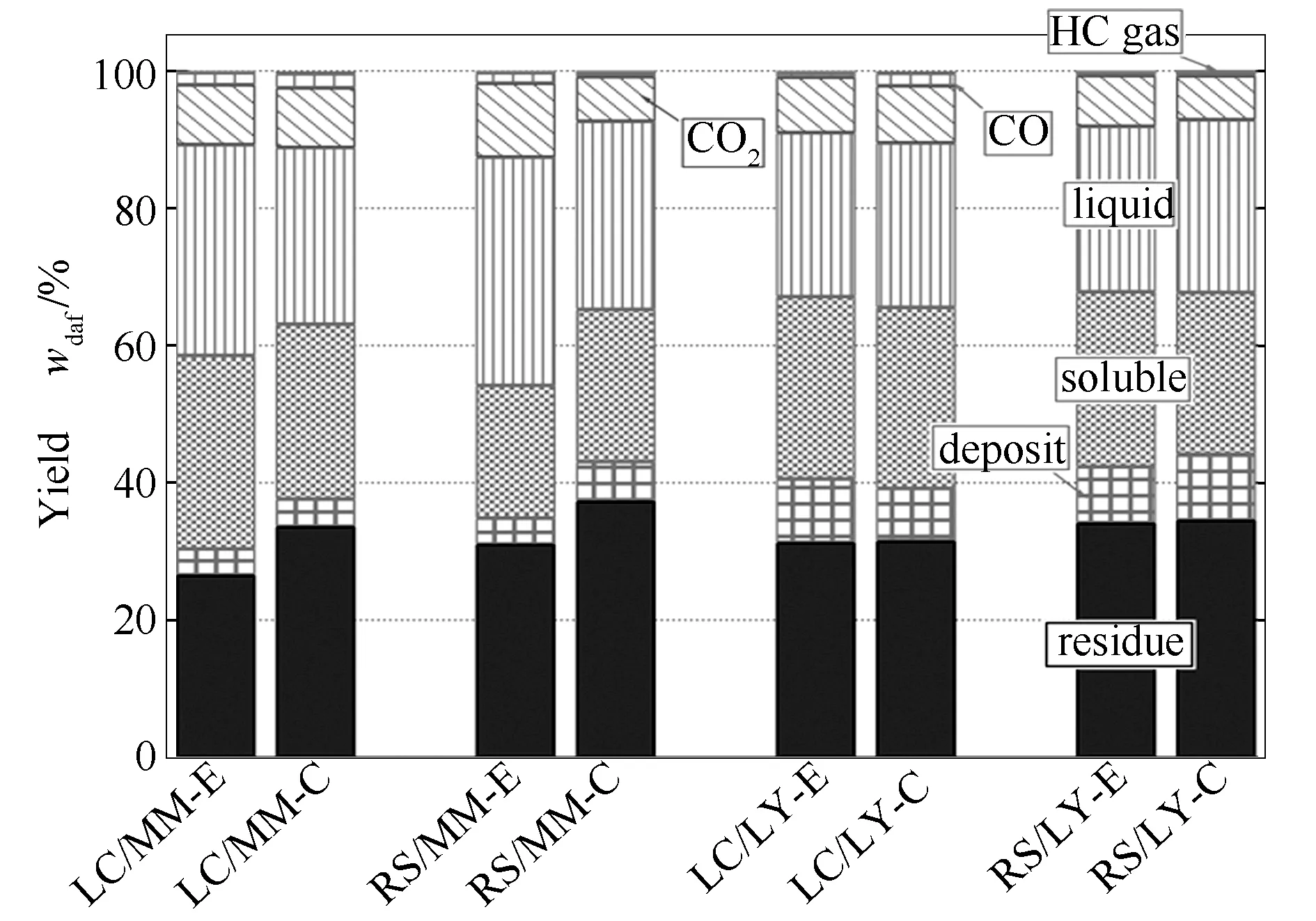
Figure 3 Extraction yields of blends
The figure shows that the experimental yield distributions of RS/LY and LC/LY extractions are rather close to their calculated yield distributions. However, the experimental yields of RS/MM and LC/MM residues are 31.1% and 26.6%, respectively, lower than their calculated yields. The experimental yields of RS/MM and LC/MM Liquids are higher than their calculated yields. It implies that there are some interaction between biomasses and MM. However, there is no clear interaction between biomasses and LY. One of the main differences between the two low-rank coals is the ash content and composition[33]. The LY coal has the ash content of as low as 1.5% on dry basis, as shown in Table 1. On the contrary, the MM coal has the ash content of as high as 25.8%. Furthermore, the major constituents of the MM coal ash include Al, Fe and Ca[34]. It is well known that such metals can catalyze the thermal decomposition of biomass[35-37]. This should be one of the main reasons for the extraction yield difference between experimental and calculated values.
2.2 Proximate and elemental composition
Table 2 shows the results of ultimate and proximate analyses of the three solid fractions.
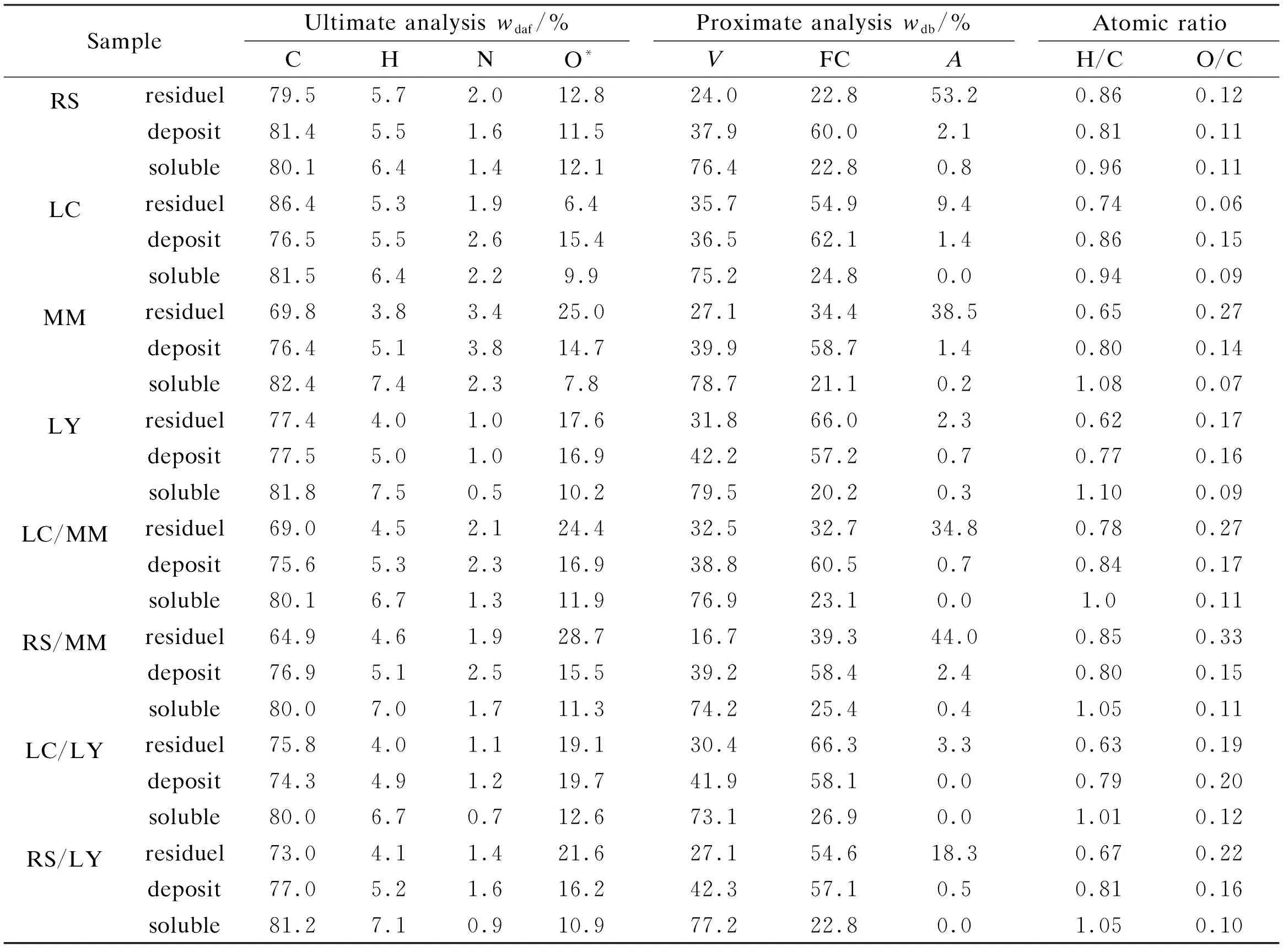
Table 2 Ultimate and proximate analyses of products
*: calculated by difference
The proximate analysis indicates that the volatile matter (V) contents of all of the solubles converge on the value of 73.1%-79.5% regardless of single material or blend. It is also the case for deposit. The solubles and deposits have rather low ash content, especially for the solubles. The ultimate analysis shows that the carbon and oxygen contents of the three solid fractions are respectively higher and lower than those of their raw materials, indicating that the raw materials are indeed upgraded. The elemental compositions of the solubles obtained from all of the single raw materials and blends are rather close to each other: carbon contents = 80.0%-82.4%, hydrogen contents = 6.4%-7.5% and oxygen contents = 7.8%-12.1%. It is also the case for deposits. These interesting results show that the proposed degradative extraction method can convert rather wide range of low grade carbonaceous materials into extracts having similar elemental compositions regardless of the raw material type. The carbon and oxygen contents of the blend residues are similar to the corresponding raw coal residues and differ with the corresponding raw biomass residues. This is because that most of the residues formed are from the coal rather than the biomass in the blends, as shown in Figure 2. Figure 4 indicates the relationships between H/C and O/C atomic ratio of the three solid fractions obtained from blends and single raw materials. The calculated results are also added in the figure for comparison. The figure clearly shows that all of the data points of solubles converge to a small region, which is H/C atomic ratio: 1.00-1.05 and O/C atomic ratio: 0.10-0.12 similar as those of bituminous coal regardless of the raw material type and their blends. It is also the case for deposits. Furthermore, there is no clear difference between the experimental and calculated results for the solubles, deposits and residues from biomass and LY blends. The H/C and O/C atomic ratio of the LC/MM and RS/MM residues are higher than their calculated results. It should be caused by the minerals in MM as mentioned above. More detailed examinations are necessary to investigate the effect of coal minerals for the thermal decomposition of biomass during the extraction. Overall, in term of elemental composition there is no obvious interaction between low-rank coal and biomass during the degradative solvent extraction.
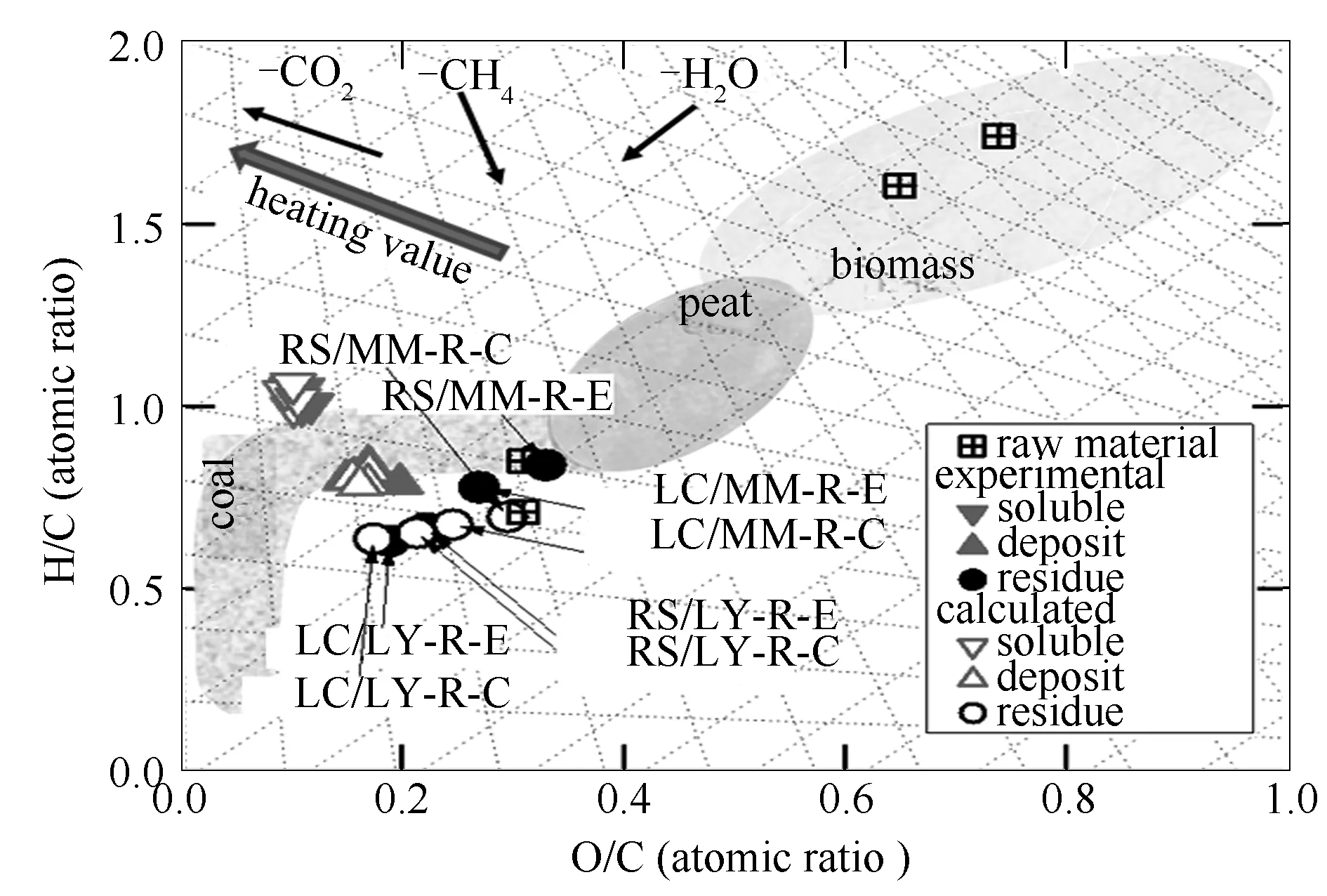
Figure 4 Experimental and calculated results of the relationships between H/C and O/C of the three fractions from blend extraction
2.3 Molecular weight distribution
Figure 5 shows the MWDs of the three solid fractions and raw materials.
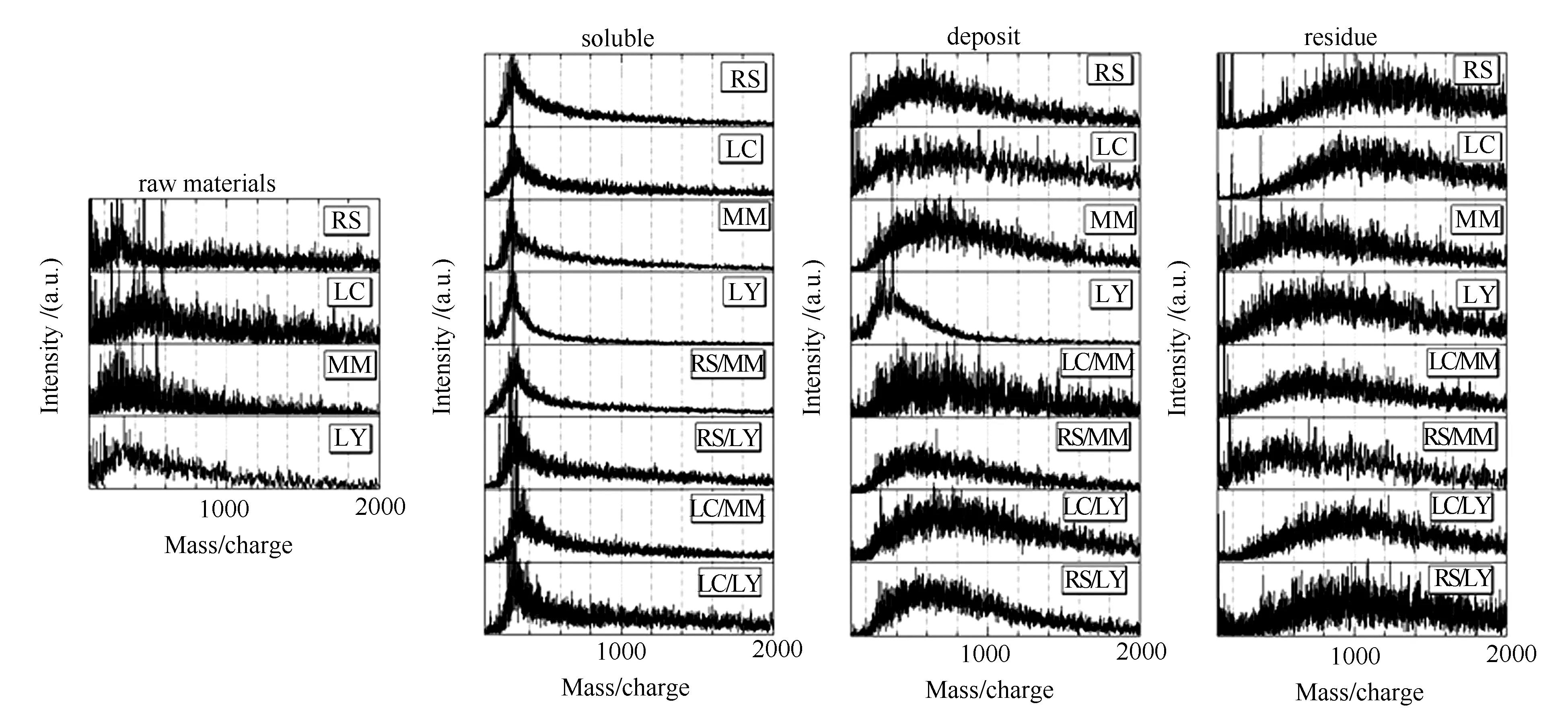
Figure 5 Molecular weight distributions of raw materials, solubles, deposits and residues
The MWDs of the solubles are in low molecular weight regions and have a sharp peak at around 300, indicating that the compounds of solubles are rather uniform. The MWDs of all of the solubles obtained from single raw materials and blends are rather similar to each other although the MWDs of the raw materials are significantly different. It is also the case for the deposits, which has a peak at around 500. Residues have higher molecular weight and wider MWD than solubles, deposits and raw materials. It is also found that the molecular weights of the residues obtained from biomasses are higher than those obtained from the low-rank coals. After comparing the MWDs of residues carefully, it can be seen that the MWDs of the blend residues are slightly higher than those of the coal residues and relatively lower than those of the biomass residues since most of the blend residues are from the coal rather than from the biomass, as discussed above.
2.4 FT-IR analyses
The FT-IR spectra of raw materials, solubles and deposits are shown in Figure 6. The FT-IR spectra of raw materials are obviously different to each other. The biomasses have more significant OH stretching bands than low-rank coal at around 3400 cm-1. There is a sharp peak at 1050-1000 cm-1attributed to C (aliphatic)-O stretching in the spectra of raw RS, LC and MM. However, the FT-IR spectra of all of the solubles obtained from single materials and blends are rather similar to each other regardless of the raw material type. It is also the case for the deposits. Besides, the main changes in the spectra from the raw materials to solubles and deposits are weakening of OH stretching bands at around 3400 cm-1, appearance of sharp peaks attributed to aliphatic C-H at 2850-2960 cm-1, appearance of other several peaks attributed to aromatic moieties at 3050 cm-1and at 770 cm-1, and disappearing of the sharp peak at 1050-1000 cm-1.
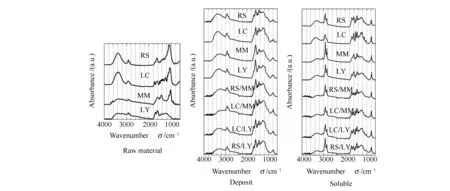
Figure 6 FT-IR spectra of raw materials, solubles and deposits
2.5 Thermal behavior examination
The thermal decomposition and thermoplastic behaviors of three solid fractions obtained from single materials and blends are also compared. Figure 7 shows the weight decreasing curves of the three fractions and raw materials obtained by TGA.

Figure 7 TGA curves of the three fractions and raw materials
Thermal decomposition behaviors of the low-rank coals and biomasses are significantly different to each other. However, the weight decrease curves of all of the solubles are rather similar to each other, regardless of single material or blend. The weight decreases of solubles start at around 200 ℃, and the main temperature range is from 250 to 450 ℃. The deposits also has similar weight decrease curves as shown in the figure. The thermoplastic behaviors of solubles, deposits and raw materials estimated by TMA are shown in Figure 8 by the solid lines. The TGA curves are also added by dotted lines in the figures to confirm that the displacement is not caused by the mass loss of thermal decomposition. The figure shows that the raw biomasses and low-rank coals have no thermoplastic behavior. However, the displacement curves of deposits and solubles reach to -1.0 at around 250 and 100 ℃, respectively before starting the decomposition reaction. It indicates that all of the deposits and solubles are completely softened and melted before starting decomposition reaction. Furthermore, the displacement curves of all of the solubles obtained from single materials and blends are rather close to each other.

Figure 8 TMA profiles (solid lines) and TGA curves (dotted lines) of solubles, deposits and raw materials
3 Conclusions
The blends of low-rank coal and biomass were treated by a degradative solvent extraction method to investigate the interaction between the low-rank coal and biomass during the extraction. The results showed that the yields and elemental compositions of the three solid fractions obtained from blends were just slight different to their calculated results. The slight differences of the yields were judged to be caused by the catalytic effect of the minerals in coal for the thermal decomposition of the biomass. The elemental composition, molecular weight distribution, chemical structure, thermal decomposition behavior and thermoplastic behavior of the extracts obtained from low-rank coal, biomass and their blends, were rather similar to each other, independent of the properties of the raw feedstocks. Overall, the interaction between low-rank coal and biomass during the degradative solvent extraction was not significant. On the other hand, the proposed degradative solvent extraction method was fit not only for single low-rank coal and biomass but also for their blends to produce the product having similar physicochemical properties.This implies that an industrial system of degradative solvent extraction can use coal, biomass or their blends as feedstock at the same time without modification or adjustment.

